| itinerary < 3 October Skradin, Hrvatska 9 October Dubrovnik > | Hvar, Hvar 6 October 2011 |
 night in Hvar |
But let me work my way to that later. Even the touristy shops appear to have a higher proportion of decent stuff (maybe 20%?), although most of it is the same old same old -- for example, you will be relieved to know there is a United Colors of Benneton here. Unlike Rovinj, some of the art is actually artistic, and some of the shops stock local and even interesting goods. The people are very different. Rather than being brusk and impersonal due to tourist fatigue, many of them remain interested and engaging. What's the difference? Is it the water? A better class of tourist? |
|
You might notice that there is a hole in this narrative, and I have temporarily abandoned my pattern of telling the story chronologically. What can I tell you? The transition from tourist to traveler at about six weeks on the road is not a smooth one for me; it's more like a birthing experience in which I let go of my connection to home and commit to being a creature of the road. Coincident with this, for me at least, and likely the precipitating event, was an awkward transition from driving to dragging luggage down the bumpy cobbles in a big, dirty, strange big city without much certainty of where I was going, dodging busses, accosted in broken English by gypsy women selling crappy lace tablecloths. In a word: Split. |
 Michael and the much-admired brass toe of Archbishop Nin |
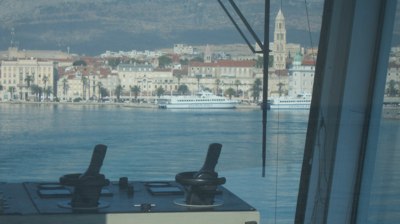 Escape from Split through the ferry wheelhouse |
Croatia's second city, Split (say, spleeet) is a large, chaotic archetype of everything that is wrong, in my view, with big cities. Retelling the story, I can't really say there was much wrong with our stay in Split. After some uncertainty, and a helpful bus driver, we found our way to our rooms ...or what we thought were our rooms. Another helpful fellow with a cell phone summoned Ivo, our host, who set us up in a strange but innovative little apartment under the eaves inside Diocletian's Palace. We stashed our luggage and set out to find lunch -- a very mediocre pizza made with cheapest available ingredients -- and explore. I think that's the story in Split: cheap rules. Not an unfamiliar story... |
|
In the afternoon, we sat and watched the parade go by on the Riva. (I have since discovered that I did not take a single picture of the Riva.) We explored the Palace basement and listened to some beautiful singing in the vesitbule of Diocletian's personal chambers. We bought a huge pomegranate and some delicious mandarins and figs in the green market. The fig lady tried to overcharge us. We bought chocolate croissants for breakfast, and our ferry tickets to Starigrad, Hvar. We tried to find creme rinse; little known fact: Croatians don't use creme rinse. We found indifferent vegetarian dinner in a back street. |
 |
A few notes about Diocletian and his palace. He was one of the longest ruling of Roman emperors, working his way up from a minor provincial functionary to emperor, then surviving in the top spot for twenty years. About halfway through, he started building his retirement villa on the shore below his natal village, and moved in, a sick man, eleven years later. Deeming the empire too big to be ruled by men obviously less capable than himself, he installed a tetrachy, four emperors each ruling a segment of the empire that then spanned from the north of England and the Morrocan tip of Africa clear to the Black Sea. Hostorians consider this the beginning of the end of the Roman Empire. I want to emphasize the time span again: this amazing pile was conceived of and completed in eleven years! |
|
|
 |
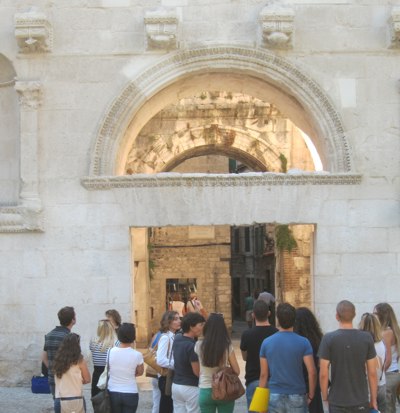 Outside the Golden Gate |
Essentially the same story can be told about most of the details inside his palace. From shortly after his death until the present, the palace's walls have served as a form for later building, while the interior has been reshaped again and again. The gates, particularly the main or Golden Gate, persist, and while most of the graceful upper floor arcades have been bricked in and the whole western side except the gate has been absorbed into a riot of what might loosely be called architecture, the walls define a space. Inside, only the central Peristile (entry square), mausoleum (now cathedral), a couple of temples that were converted to christian purposes, and the vestibule (entry) to the Emperor's personal living space, survive. There's a picture of the vestibule, minus the dome that once completed it, below. The double arched Golden Gate is impressive, too. Despite the bricked in windows above (for centuries now a Benedictine nunnery) it's the place where tour groups congregate to get a feel for how marvelous this building must have been when it had the simple purpose of housing a retired Emperor. |
|
Long ago, the new residents of developments within the walls discovered that if they poked a hole in the floor they could shove stuff down there more or less endlessly. This went on for a millennium. In the late 19th Century, archaeologists discovered the entrance to what had once been galleries beneath the palace, hastily but strongly built to support the square palace on its sloping site. The galleries having been stuffed full of the waste of centuries, provided generations of archaeologists (including some to come; some of the trash remains) with a bounty of insight into the residents, old and really old, of the palace. In fact, the basement presumably being an echo of the structure built above, much of what is known about the original palace is deduced from its underpinnings. Today, it is mostly shops selling kitsch and ridiculously expensive shoes, a few restaurants and travel agencies. Even the basement has its most direct access, from the water gate, called the Brass Gate, cluttered with stalls selling the most lamentable imported crap imaginable. |
 |
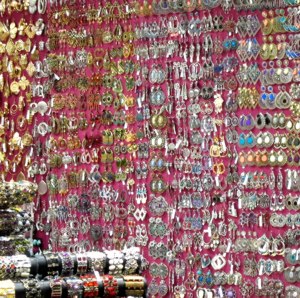 Modern trash |
After dinner, we sat and watched the parade go by on the Riva. Split is famous for its long legged, big breasted, slavic featured women, and we saw some of them, along with lots of young couples with children out for their evening walk. We threaded back through the chaotic warren of the Palace to our apartment, which was amazingly quiet considering the concentration of humanity that lives and works there. We slept sorta okay, despite recycled dreams originally dreamt by violent people for a millennium and a half. We watched the National Geographic channel with Hvratska subtitles. My puzzlement persists about this kind of tourist schlock. The rent on these stores can't be cheap. Either people actually go in and find something out the welter that they want to remember Spilt by, or the welter of crap in the stores is a front, and there's something going on in the back room. |
|
For breakfast, we made tea and ate our croissants. We discovered that TripAdvisor.com had mistakenly booked us into Pansion Kiko, supposedly in Starigrad on the island of Hvar but actually Stari Grad near Paklenika, a rocky national park 200 kilometers behind us, and that not appearing for our reservation would cost us 65 euros. (We'll see about that! When you ask TripAdvisor to book you into somewhere and it books you somewhere else far out of the way, whose fault is that?) Wise Rochelle weathered all this, and managed to keep me from hurting myself, but there were some bad moments and some mumbling about just wanting to be in my nice Caspar beddy with my catty. I cannot imagine how people travel alone, because there are so often moments when one person gets lost or discombobulated, and having a second balance is crucial. "This may turn out to be a blessing in disguise," she said, because we had now read enough in our guidebook to be sure that we didn't want to be in Starigrad, (which means "historic city" but in this case isn't telling the truth. Hvar is the ancient city) but in the walled city of Hvar, said to be much more interesting. |
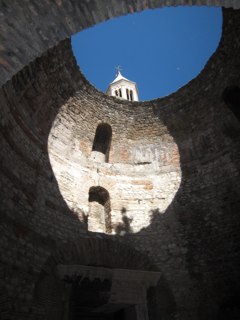 The impressive vestibule -- the Ex-emperor will see you now... |
 |
We fired off desperate emails to accommodations in Hvar, but heard nothing back. Rochelle induced me to stop fretting. To consume time before our 14:30 ferry, we sat and watched the parade go by on the Riva. We had indifferent salad and spaghetti. We got on the ferry and chilled for two hours while it threaded between pine-covered low islands in a blue, blue sea dotted with sailboats. The guidebooks say, "Busses to Hvar meet the ferries. Tickets cost 20 kuna." Not. At least, not the afternoon ferry. So we took a taxi for 200 kuna; our taxista, a huge burly fellow named Robert, turned out to be a gem (of course) who did his best to find us a place in Hvar after zipping us over and through the mountain. "I can not imagine living anywhere but Hvar," said Robert over the blare of Linnard Skinnerd. "So slow paced and gentle." It could be a Greek island: karst rocks and blasted little trees and plants except in sheltered spots ... like Hvar. |
|
Robert gave up when his Hvar friends all came up empty, and consigned us to the Tourist Information (TI). I overpaid him anyway, because he was a good guy that cheered me up. The TI told us, "We don't find lodging. You must go to an agency" and drew us a map. The agency was closed. I said "This has the makings of a serious nightmare." Rochelle said, "No, this is a blessing in disguise." |
 |
|
|
There were two kinds of stuffed bread, sort of like calzone, that smelled delicious and were exceptionally tasty. A plate of three local meats and two local cheeses surprised us. Delicious lemonade, the first we have seen on the trip. Lovely local white wine. For dessert, Pijane Smokve – "drunken figs," figs stuffed with almonds then marinated in local brandy – and Prošek, local sweet white wine like what we call muscat. Throughout the dinner our server checked on us, explained things, and made sure we were pleased. I mentioned that at home I am a chef, so when the bill came, it included a 10% courtesy discount, one chef to another. Nice touch! |
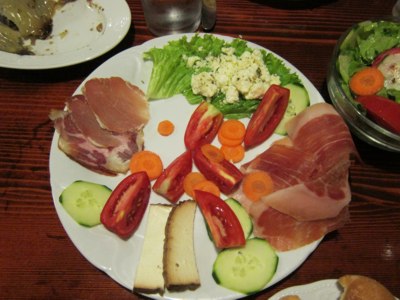 Ooops, Sorry, hunger overcomes photography. We have aleady started when I remember to haul out the camera... |
 |
Here in Hvar, said to be the sunniest island in the Adriatic, many houses, especially the nice ones in the upper class old town within the walls below the fortress, have lovely back yards with trees and gardens. The town has defended itself against pirates and marauders from the east since (at least) before 500 BCE. Much of its current excellent stonework was built during the time of its supervision by the Venetians, the Adriatic's dominant force. |
|
Beyond the town, the harbor, dotted with busy boats going this way and that, snakes out past a maze of rocks and barrier islands dotted with famously beautiful beaches and infamously dangerous rocks. Not for us; the weather today is still sultry but a southeast wind is beginning to blow, promising a change in the weather. Somehow, neither the Med, the Aegean, nor the Adriatic appeal to me as a place to swim.The nautical museum in the Fortress showed artifacts recovered from three shipwrecks of the numberless ones found here -- divers don't see many fish here in these overfished waters, but they come for the wrecks. It has been said that in ancient times, one of fifty voyages ended in a shipwreck. |
 |
 |
We visited the lace museum, run by Benedictine Sisters who have a convent here and use their spare time delicately separating out agave fibers, tying these short fibers into long threads, and then crochetting them into elaborate geometrical forms with no practical use. The story goes that they live to get an order for lace to decorate a high churchman's vestments, and recently completed a large papal seal to commemorate the visit to Croatia by the present Pope.
Here's another example of a place where God's minions don't want pictures taken. If you want to remember this place, or show someone, you must either buy an exceedingly (and understandably) expensive, but nevertheless inferior, sample of the work -- a few dozen mediocre examples are available for several hundred dollars a pop -- or a poorly rendered postcard of one of the less interesting pieces. The gimlet-eyed nun in the fron room couldn't see me sneak this picture. (But I'll probably go to Hell...) |
|
We wandered through the narrow streets, enjoying the stonework and history. In the green market we saw the white peppers and all the other vegetal ingredients for last night's dinner ...but beyond a simple breakfast we have no intention of trying to cook anything in our cramped little kitchen. Not when there appear to be wonders aplenty outside. Rochelle popped into another supermarket -- this one was pretty super, because it produced creme rinse we couldn't find in Split. (Just mentioning that city's name makes my heart race ...and we have to go back there on Saturday to catch our bus to Dubrovnik. Grrrr.) Out in the best spot for a restaurant on the promenande we had noticed Ostionika Gariful, which gets good mentions in our guidebooks. It's enough out of the center, and was doing a big enough business last evening, that we thought to try it. A beautiful 270 degree view of the harbor and barrier islands, linen table cloths and enough glassware to signify serious dining. A two page menu (in five languages) including a listing for "1st class fish, today fresh...400 kuna/kg." Incidentally, inside the restaurant there are fish swimming beneath the glass floor, but I don't think they're for dinner. |
 |
 |
 |
The waiter brought out a beautiful immense platter of catch "just in from the boat" – believably so; the dorado still shimmered gold. Sea bream, a fat bright red scorpionfish. We chose a lovely corvina, and after our salads (delicious if boringly predictable) out came our corvina, beautifully charcoal grilled. "Would you like help?" asked our waiter. Of course. He expertly boned and shared it between us. Tartar is a specialty here, never bottled in a good restaurant, so I asked for some: garlicky, lemony, a perfect compliment to the buttery corvina. In the evening, after a very satisfactory Mediterranean salad (has feta) and a Margherita pizza (just the elements: tomato and what passes for mozzarella locally) at Alviž we went and sat in the Cathedral and were, first, amused by the chatter of an Aussie group sitting in the pew behind, and then awed by the sound of a good organ in a big hard-surfaced space driven by a masterful organist, in this case one Draško Baumgarten, imported for the event, it says on the flyer, from Rijeka and Ljubljana. |
|
We never really saw the fellow; he was at the console up in the choir loft, and we could see his head bobbing away if we turned all the way around in our pews... but it was purely about the sound. Maybe his feet got a little tangled on the low passages of Bach's Toccata and Fugue in D-mol. Maybe I've even heard the piece played better on a better organ. But not last night. In this place, at this time, what he played for us was magnificent and completely delightful. |
|
Our last day in Hvar was as pleasant as the first, although we could see the weather closing in, and we elected to stay in for the evening when the storm actually hit: rain bursts, gusts of wind, and even some lightning and thunder. We took a long walk, as far along the promenade to the north and west as we could go. At the end I clambered out on the rocks and was once again surprised by how devoid of inter-tidal life the Mediterranean and its various arms are. Obviously there are fish, and they must eat something, but millennia of population pressure on the zone at the edge has pretty much wiped out the interesting life. I saw a sea star ...and as soon as it saw me seeing it, it moved itself as fast as its little arms would carry itinto a hole. A crab the size of a quarter: ditto. Some urchins. A bunch of trashy looking seaweed, the same monocrop I've seen in the Aegean. Nothing even beginning to resemble diversity. |
 |
 |
The rocks are gorgeous, though, Edward Weston forms with lots of interesting colors and knife-edge ridges that make getting around on the rocks a challenge. And the water is as advertised, clear and aquamarine. |
|
We had a list of three restaurants to try, and we had checked them out in order so far; for lunch, we went t Giaxa -- pronounced, and spelled by Rick Steves, Yacsa. A very gentlemanly young waiter took great care of us -- for most of lunch we were the only ones in the graceful courtyard. We started with linguine with clams, the little nubbly-shelled ones found in these parts with the little chewy bodies and the great big flavor -- I guess they live a tough life, and so they cram their quantum of clamminess into a smaller than average body. Next, out came the apparatus for a production: plates and utensils for us, implements and a hot pad, a platter for operations. And then, a huge cast iron vessel bigger than your large frying plan, hotenough to require two potholders, and in it swimming three kind of fish, thinly sliced onions and potatoes, and simple but strong herbs, in a wine-and olive oil broth. |
 |
|
Our waiter introduced the main characters -- Sea bream, sea bass, and jondory or, as it's called in this part of the world, Saint Peter -- and offered to help debone them. We of course gratefully accepted, and he operated for some minutes, commenting that this dish, called Hvarska gregada, is the local fisherman's stew or bouillabaise. Simpler than bouillabaise and, I think, much more honest with the fish, but better, he said, when there are at least these three fish in it. He carefully extracted the cheeks from the fish head floating around and tenderly gave us each one. We ate until we hurt. Even so, we couldn't finish ...and this was supposed to be one portion! It was delicious, and it was a real struggle for me to leave anything. As I write this almost 24 hours later, I am still not hungry again. |
 |
updated 18 November 2024 Caspar Time site software and photographs by the Caspar Institute except as noted this site generated with 100% recycled electrons! send website feedback to the CI webster © copyright 2002-2024 Caspar Institute |